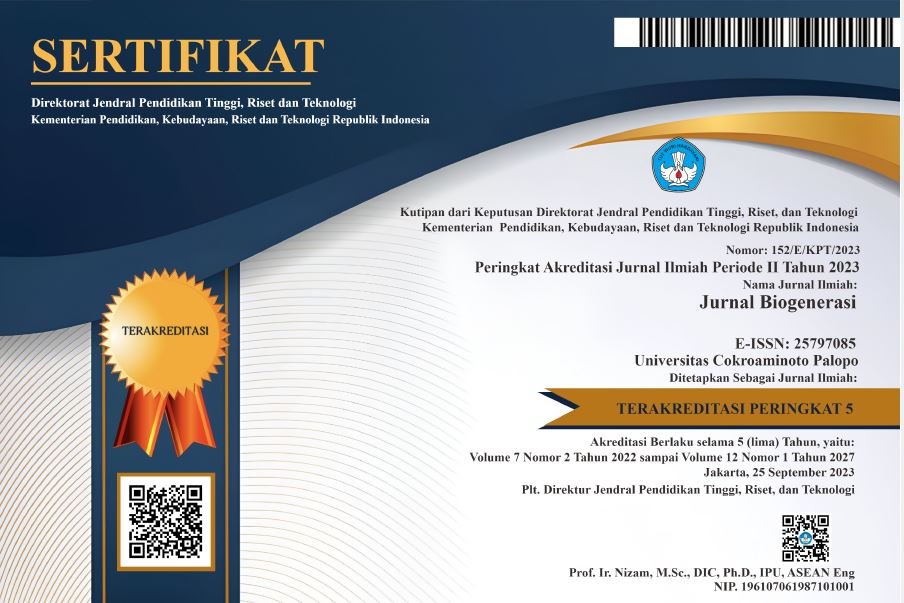POLA PRODUKSI BIOLISTRIK KONSORSIUM BAKTERI TERMOFILIK SUMBER AIR PANAS SAPAN SUNGAI ARO
DOI:
https://doi.org/10.30605/biogenerasi.v10i2.6106Keywords:
Bioelectricity, thermophilic bacteria, ratio concentration, bacterial consortiumAbstract
This study aims to investigate the bioelectricity production pattern of a thermophilic bacterial consortium from Sapan Sungai Aro. Thermophilic bacteria, which can survive at high temperatures, have the potential to generate electricity through their metabolic activity. In this study, the thermophilic bacterial consortium was isolated from Sapan Sungai Aro and tested for bioelectricity production at a 5% concentration with various consortium ratios (1:2, 2:1, 1:3, 3:1). The data show that the stationary phase at the 20th hour produced the highest voltage, which was 0.764 V, at the 3:1 ratio. These results indicate that the optimal composition of the bacterial consortium influences the efficiency of bioelectricity production. Moreover, this study also reveals that both the exponential and stationary phases play important roles in electricity generation, with the stationary phase providing the most ideal metabolic conditions
Downloads
References
Bai, X., Tong, L., Nan, L., Bing-Zhi, L., Hao, S., & Ying-jin, Y. (2021). Engineering synthetic microbial consortium for efficient conversion of lactate from glucose and xylose to generate electricity. Biochemical Engineering Journal, 172.
Cahyani, L. (2013). Pemanfaatan tepung cangkang udang sebagai media produksi kitinase oleh bakteri kitinolitik Isolat 26 [Bachelor thesis, University of Jember].
C. D. Rolfe, M.D., Christopher, J.R., Sacha, L., Carmen, P., Arthur, T., Andrew, D.S., Cameron, M.A., Michael, F. S., Roy, P.B., Jozsef, B., Michael, W.P., dan Jay (2012). “Lag Phase Is a Distinct Growth Phase That Prepares Bacteria for Exponential Growth and Involves Transient Metal Accumulation,” International Journal of Bacteriology, vol. 194, no. 3, pp. 686–701.
Dai, K., Wen, J.-L., Zhang, F., Ma, X.-W., Cui, X.-Y., Zhang, Q., Zhao, T.-J., & Zeng, R. J. (2017). Electricity production and microbial characterization of thermophilic microbial fuel cells. Bioresource Technology. https://doi.org/10.1016/j.biortech.201.06.167
Dessi, P., Porca, E., Haavisto, J., Lakaniemi, A.-M., Collins, G., & Lens, P. N. L. (2018). Composition and role of the attached and planktonic microbial communities in mesophilic and thermophilic xylose-fed microbial fuel cells. Royal Society of Chemistry, 8, 3069-3080.
D. P. Madigan, M. T., Martinko, J. M., Stahl, D., & Clark. (2012). Brock Biology of Microorganisms (13th Edition). New York: Pearson.
Fitriani, F. Z., Suyati, L., & Rahmanto, W. H. (2017). Pengaruh Konsentrasi Substrat Maltosa terhadap Potensial Listrik Baterai Lactobacillus bulgaricus (MFC). Jurnal Kimisa Sains dan Aplikasi, 20(2): 74-78.
J. M. M. and J. P. Madigan, M.T. (2002). Brock Biology of Microorganisms. Prentice hall International Inc.
Kusnadi. (2009). Mikrobiologi: Buku Teks Umum. Universitas Pendidikan Indonesia.
Madigan, M. T., Martinko, J. M., Stahl, D. A., & Clark, D. P. (2012). A brief journey to the microbial world. In Brock biology of microorganisms, 13th ed., 25–30.
Saragih Veby. (2018). PENGARUH EKSTERNAL RESISTANSI DAN PENAMBAHAN MOLASSES PADA LUMPUR LAPINDO UNTUK MENGHASILKAN BIOLISTRIK DENGAN
MENGGUNAKAN MICROBIAL FUEL CELLS. Skripsi: INSTITUT TEKNOLOGI SEPULUH NOPEMBER.
Siregar, M., & Prayitno, S. B. (2016). Pengaruh Konsentrasi Konsorsium Bakteri K1, K2 Dan K3 Terhadap Status Kesehatan Rumput Laut (Eucheuma Cottonii). Journal of Aquaculture Management and Technology, 5(1): 91-97.
Susilowati, P. E., Raharjo, S., Kurniawati, D., Rahim, R., Sumarlin, A., & Ardiansyah, A. (2012). Produksi Xilanase dari Isolat Sumber Air Panas Sonai, Sulawesi Tenggara, menggunakan Limbah Pertanian. Jurnal Natur Indonesia, 14(3): 1-6.
Timmis, K.N., de Lorenzo, V., Verstraete, W., Ramos, J.L., Danchin, A., & Brüssow, H. (2014). Microbiology and environmental biotechnology: facing the challenges of the Anthropocene. Environmental Microbiology, 16(5), 1228–1239.
Yadav, M., Sehrawat, N., Singh, M., Kumar, V., Sharma, A. K., & Kumar, S. (2021). Thermophilic microbes-based fuel cells: an eco-friendly approach for sustainable energy production. In Bioremediation for Environmental Sustainability. https://doi.org/10.1016/B978-0-12-820318-7.00011-3
Downloads
Published
How to Cite
Issue
Section
License
In submitting the manuscript to the journal, the authors certify that:
- They are authorized by their co-authors to enter into these arrangements.
- The work described has not been formally published before, except in the form of an abstract or as part of a published lecture, review, thesis, or overlay journal.
- That it is not under consideration for publication elsewhere,
- That its publication has been approved by all the author(s) and by the responsible authorities – tacitly or explicitly – of the institutes where the work has been carried out.
- They secure the right to reproduce any material that has already been published or copyrighted elsewhere.
- They agree to the following license and copyright agreement.
License and Copyright Agreement
Authors who publish with this journal agree to the following terms:
- Authors retain copyright and grant the journal right of first publication with the work simultaneously licensed under Creative Commons Attribution License (CC BY 4.0) that allows others to share the work with an acknowledgment of the work's authorship and initial publication in this journal.
- Authors are able to enter into separate, additional contractual arrangements for the non-exclusive distribution of the journal's published version of the work (e.g., post it to an institutional repository or publish it in a book), with an acknowledgment of its initial publication in this journal.
- Authors are permitted and encouraged to post their work online (e.g., in institutional repositories or on their website) prior to and during the submission process, as it can lead to productive exchanges, as well as earlier and greater citation of published work.


.png)

